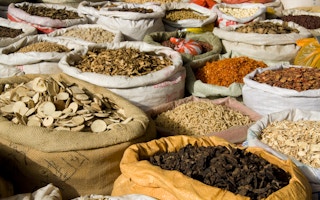Traditional medicines and their natural sources must be protected from threats such as illegal wildlife trade to secure their role in narrowing the global health gap, say scientists.
For millions of marginalised communities, traditional medicine is the only recourse for meeting their primary healthcare needs, especially in remote and rural areas that lack access to formal healthcare systems.
The World Health Organization (WHO), which held its first-ever Traditional Medicine Global Summit in Gandhinagar, India, from 17 to 18 August, estimates that 80 per cent of people in most Asian and African countries use some form of traditional medicine for primary healthcare.
“Developing countries need not look towards developed countries to provide solutions, rather they can embrace what they already have – indigenous knowledge…grounded in generations of experience,” said Ritu Bharadwaj, principal researcher in the UK-based climate change research group of the International Institute for Environment and Development.
“By tapping into this wisdom, especially based on experiences from regions like Western Santo in Vanuatu and Okavango Delta in Botswana, we can devise strategies that are both effective and contextually relevant, including traditional medicinal plants and the health of communities that depend on them,” Bharadwaj told SciDev.Net.
Interest in traditional, complementary and integrative medicine (TCIM) is growing from both the pharmaceutical and cosmetic industries, with multinational corporations moving into this space through partnerships and acquisitions.
In India, the practice of yoga and naturopathy, and the production of Ayurvedic, Unani, Siddha and homoeopathic medicines and supplements, is expected to reach US$24 billion in 2023, with 84.2 million patients using them, Rajesh Kotecha, secretary in the Ministry of AYUSH, told the WHO summit.
“
The UN Convention on Biological Diversity is our safeguard against biopiracy and patenting of our traditional knowledge and biodiversity. It should be defended and strengthened internationally in every country.
Vandana Shiva, founder, Navdanya
The ministry is responsible for promoting traditional medicine, through education and research.
Around 40 per cent of pharmaceutical products are drawn from nature and traditional knowledge, including drugs such as aspirin, artemisinin, and treatments for childhood cancer, cardiovascular disease and hypertension.
Experts say there is a vital need to foster conservation and sustainable use of biodiversity, empower indigenous communities, and build evidence on the efficacy and safety of traditional medicines.
“The UN Convention on Biological Diversity is our safeguard against biopiracy and patenting of our traditional knowledge and biodiversity,” said Vandana Shiva, Indian physicist and founder of the non-profit Navdanya, an organisation of seed keepers and organic farmers in India. “It should be defended and strengthened internationally in every country.”
The challenges of biodiversity loss, emerging infectious diseases and climate change have underscored the need to protect traditional medicinal sources and the people who depend on them.
“Given that Big Pharma is based on monopoly, super profits and destroying indigenous and alternative knowledge systems, countries of the South should promote their indigenous health systems,” Shiva told SciDev.Net.
Over 80 per cent of the world’s remaining biodiversity – forests, deserts, grasslands and marine environments – is managed by indigenous peoples, even though they comprise about five per cent of the global population.
Illegal wildlife trade
Direct overexploitation is the second most significant cause of biodiversity decline, threatening a million species with extinction. And illegal wildlife trade, driven by demand for traditional medicines, is one of the factors fuelling this decline.
“The Covid pandemic highlighted the need to ensure safe and sustainable wild species trade,” said Richard Scobey, executive director of TRAFFIC, a non-governmental organisation working to ensure that trade in wild species is legal and sustainable.
“The world must take this prime opportunity to combine multi-convention targets through a One Health approach.”
WHO-led investigators were tasked with trying to identify the zoonotic source of the SARS-CoV-2 virus and route of introduction to the human population, but their findings have been inconclusive.
TRAFFIC Viet Nam’s recent online market surveys reveal that illegal wild species products are still sold online as traditional medicine healthcare and treatment ingredients.
Specifically, new products such as tiger bone glue and rhino horn glue have emerged on the Vietnamese market and might further threaten the species in the wild.
In another survey, almost 60 per cent of traditional medicine practitioners in Viet Nam admitted having recommended illegal products over the previous two years.
“We have been engaging with the government, traditional medicine association, hospitals, universities and pharmaceutical companies to drive down the use of illegal wild species products in the sector through professional training and placement of social and behaviour change messages,” Trinh Nguyen, director of TRAFFIC Vietnam, told SciDev.Net.
But Oommen Kurian, senior fellow and head of health initiative at Observer Research Foundation, an independent global think tank, cautions: “While traditional medicine can expand access to care, it must not serve as a substitute for systemic solutions aimed at providing equitable access to modern medicine.”
The WHO traditional medicine summit committed to harnessing the potential of evidence-based TCIM to improve progress towards universal health coverage and SDGs 2030 for the health and well-being of people and the planet.
Scientists point out that building scientific evidence for TCIM, using the paradigm of the double-blind randomised placebo-controlled trials, used to evaluate the efficacy of pharmacological agents, can be challenging.
However, new research methods such as ethnopharmacology and reverse pharmacology, along with new diagnostic technologies and artificial intelligence, could open new frontiers of knowledge on traditional medicine.
This article was originally published on SciDev.Net. Read the original article.

















